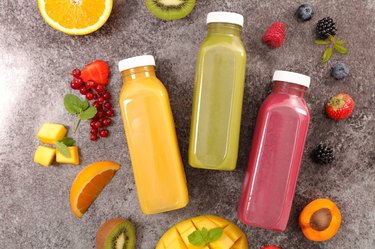
Have you have been instructed to eat a soft food or full liquid diet by your doctor? Are you looking for better ways to fit more fresh produce into your diet? Whole fruit smoothies can provide an abundance of nutrients in an easy-to-eat package.
Tip
Blended fruit smoothies retain the nutrients of the whole fruit, especially if you include the skins. Drink them fresh to get the most benefit.
Video of the Day
Why Eat a Liquid Diet?
There are a number of health- and wellness-based reasons why you might want to incorporate more liquid meals into your diet. According to the U.S. National Library of Medicine, a full liquid diet is often required for patients preparing for surgery or other medical procedures. Soft-food diets are also common for people who have trouble swallowing or who experience pain or other issues with chewing.
Video of the Day
Smoothies are a popular meal replacement. Using information from the U.S. Census data and Simmons National Consumer Survey (NHCS), Statista estimates that more than half of all Americans consumed yogurt and smoothies in 2019. When blending fruit in recipes for a regular breakfast, lunch or snack, the right mix of ingredients can provide a satiating, nourishing meal.
Juice vs. Whole Fruit Smoothies
There are pros and cons to both juices and smoothies, writes Beverly Merz, the executive editor at Harvard Women's Health Watch. Freshly squeezed and cold-pressed juices tend to have more vitamins and minerals than heavily processed or cooked vegetables, and they also tend not to have artificial sweeteners or added sugars. Mixed-fruit juices are also likely to contain a wider variety of nutrients than a single piece of fruit.
Smoothies may be more satiating, writes Merz. They are also a great way to sneak vegetables into your diet, as blended fruits like tart berries, or sweet, ripe peaches, can easily mask the flavor of added greens like spinach. Leave out the added sweeteners for the most healthy blended fruits recipes.
Melissa Montalto, Registered Dietitian and Certified Diabetes Educator, writes for the Whole U at the University of Washington that "with smoothies, you retain the fiber [of fruits], which can help you feel fuller and improve your digestive health. In addition, you can add other types of foods to smoothies, like nuts, seeds, and yogurts, to increase your intake of healthy protein and fats."
Does a Smoothie Lose Nutrients?
The Harvard T.H. Chan School of Public Health confirms that whole fruit smoothies containing skin, pulp and flesh retain the nutrients and fiber present in the fresh fruit, but suggests that whole fruit might provide slightly more satiety, keeping you from getting hungry longer. Juices, even when fresh, may lose nutrients through processing. Preserved juices, even when made entirely from fruit juice without additives, lose nutrients through the bottling process.
Choose smoothies to boost your daily intake of fruits and vegetables but avoid using them as your only source of produce. An August 2013 study in the British Medical Journal found that adults who ate at least two servings a week of whole fruits had a 23 percent lower risk of developing Type 2 diabetes. The same study suggests that extracted juice may actually increase diabetes risk.
Make your smoothies at home so you can control the ingredients and avoid added sugars. You can try out new and unusual smoothie recipes, but be sure to balance out the fruit content with leafy greens.
- U.S. National Library of Medicine: "Full Liquid Diet"
- Statisti: "U.S. population: Consumption of Yogurt and Smoothies from 2011 to 2023"
- Harvard Health Blog: "Are Fresh Juice Drinks as Healthy as They Seem?"
- The Whole U: "Juicing vs. Blending – What’s the Difference?"
- THe Nutrition Source, Harvard School of Public Health: "Common Questions About Fruits and Vegetables"
- British Medical Journal: "Fruit Consumption and Risk of Type 2 Diabetes: Results from Three Prospective Longitudinal Cohort Studies"